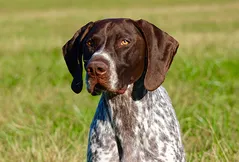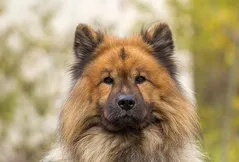
German Shorthaired Pointer
The German Shorthair is a multipurpose hunting dog who doubles as a great family companion.
Overall Status
| Height | 21 to 25 inches |
| Temperament | Friendly, Smart, Willing to Please |
| Weight | 45 to 70 pounds |
| Life Expectancy | 12 to 14 years |
| Coat Color | Black, Brown, White |
| Barking Level | When Necessery |
Quick Factors
| Playfulness | |
| Dog Friendly | |
| Exercise Need | |
| Grooming Needs | |
| Strangers Friendly | |
| Family Affectionate |
Daily Care
Grooming Tips
The German Shorthair’s water-repellent coat has thick, short hair that protects the dog from brush and helps insulate him from the cold. The coat itself is easy to care for — brush it weekly with a rubber hound mitt or firm bristle brush to keep the hair and skin healthy — but the breed has a couple of grooming quirks you should be aware of.First, the German Shorthair sheds. More than that, he sheds dark and light hair, so it will show up on your clothes and furniture, no matter what color they are. The coarse hairs are often difficult to remove from upholstery and carpet. Seasonally, the German Shorthair has a heavier shed, called “blowing coat.” He’ll need more frequent brushing and bathing during this time to remove all the dead hair.Check the ears on a weekly basis for signs of infection, irritation, or wax build up. Cleanse regularly with a veterinarian-approved cleanser and cotton ball. Brush the teeth at least once per week to prevent tartar buildup and fight gum disease. Additionally, nails should be trimmed once per month if the dog does not wear down the toenails naturally.
Exercise Tips
This breed is high-energy and needs a vigorous workout. Without it, this breed can become high-strung, hyperactive, frustrated or display destructive tendencies.With this said, Toller puppies should not be given too much exercise because their joints and bones are still growing and too much pressure on them could result in causing a dog a few problems later on in their lives. They should not be allowed to jump up or off furniture nor should they be allowed to run up and down the stairs because this puts too much pressure on their still growing joints and limbs.Walks – Long, brisk walks (45+ minutes)Hikes– A great mental and physical activity for this breed. If you and your dog are in shape, pick more challenging walks.Dog Parks– a well-suited energy outlet for this breed, a romp in the park with some friends can give a good workout.Running – these are hard-working dogs and great partners for distance runsPulling activities such as carting, scootering and skijoringWater play and sports likeswimming, walking on the beachand dock jumpingDog Sports training:Agility,Tracking,Flying Disc
Feeding Tips
If you get a German Shorthaired Pointer puppy from a breeder, they would give you a feeding schedule and it's important to stick to the same routine, feeding the same puppy food to avoid any tummy upsets. You can change a puppy's diet, but this needs to be done very gradually always making sure they don't develop any digestive upsets and if they do, it's best to put them back on their original diet and to discuss things with the vet before attempting to change it again.Older dogs are not known to be fussy eaters, but this does not mean they can be given a lower quality diet. It's best to feed a mature dog twice a day, once in the morning and then again in the evening, making sure it's good quality food that meets all their nutritional requirements. It's also important that dogs be given the right amount of exercise so they burn off any excess calories or they might gain too much weight which can lead to all sorts of health issues. Obesity can shorten a dog's life by several years so it's important to keep an eye on their waistline from the word go.Learn about which human foods are safe for dogs, and which are not. Check with your vet if you have any concerns about your dog’s weight or diet. Clean, fresh water should be available at all times. Like many large breeds, Saint Bernard can experience bloat, a life-threatening condition where the stomach distends and twists. The causes of bloat aren’t fully understood, but experts agree that multiple, small meals per day and preventing vigorous exercise around mealtimes may help reduce the chances of it happening.
Health Tips
All dogs have the potential to develop genetic health problems, just as all people have the potential to inherit a particular disease. Run, don’t walk, from any breeder who does not offer a health guarantee on puppies, who tells you that the breed is 100 percent healthy and has no known problems, or who tells you that her puppies are isolated from the main part of the household for health reasons. A reputable breeder will be honest and open about health problems in the breed and the incidence with which they occur in her lines.The average life expectancy for the GSP is between 12 and 14 years. Breed health concerns may includebloat, central diabetes insipidus, cleft palate,cranial cruciate ligament rupture (CCL or ACL), epilepsy,eye problems, hereditary lupoid dermatosis, oropharyngeal neoplasia and nasal cavity tumors,von Willebrand diseaseand XX sex reversal.
Trainability
Early training is essential for the German Shorthaired Pointer. Socialization and puppy training classesare vital, continuing with practice in basicobedience commands. This is an intelligent breed that learns quickly with consistent training sessions. GSPs need a purpose, and without one they can be destructive if left to their own devices. The breed can be extremely challenging from 6 months to 3 years old. GSPs have a very high energy level and a strong prey drive, and they need an owner with an active lifestyle to guide the dog’s exuberance and intensity into positive outlets.Puppies should be properly socialized to develop the amiable, outgoing personality that is characteristic of the breed. They’re successful in performance and companion events such as earthdog, barn hunt, obedience, and agility.
History
The German Shorthaired Pointer is an early example of fine German engineering. He was created in Germany in the mid- to the late 19th century to be a multipurpose hunting dog. The GSP was probably derived from the German bird dog crossed with various German scenthounds. English Pointers were brought in to give the new breed some elegance.Besides being a super hunting dog, the German Shorthair is a standout in the show ring. Two German Shorthairs have taken Best in Show at Westminster Kennel Club: Ch. Kan-Point’s VJK Autumn Roses (Carlee) in 2005 and Ch. Gretchenhof Columbia River in 1974.The GSP has been hunted with success on a variety of quarry: game birds, possum, rabbit, raccoon, and even deer. With his webbed feet and sleek but sturdy construction, the GSP burnishes his résumé as one of dogdom’s finest swimmers. Emblematic of the breed’s eager versatility was Marvin, a GSP from North Carolina, who in late 2013 achieved his 75th AKC title.






